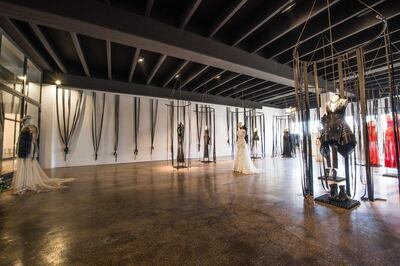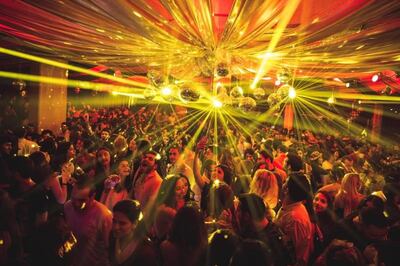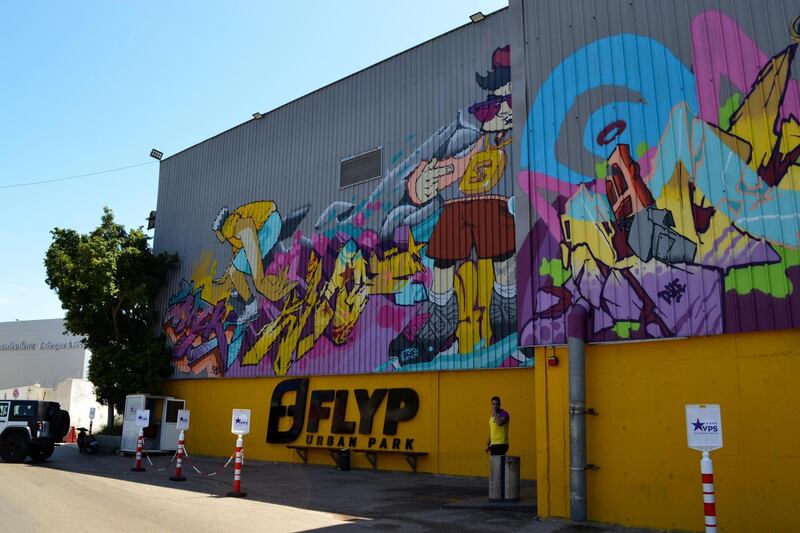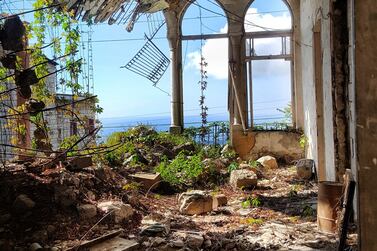In a three-storey warehouse in a suburb in the north of Beirut, a photographer, a fashion designer, a gallerist, an architect and a designer of high-end jewellery work side by side. Over the last four years D Beirut, a former steel factory and warehouse located beside the old seaside road just north of the capital, has brought artists and designers flocking to an industrial quarter of the city.
Eric Jureidini and his brother originally purchased D Beirut to use as a steel factory. Four years ago, after talking to several local architects, they decided to redesign the building and transform it into a cultural space, renting out large units to long-term tenants. “The idea is to be almost in Beirut, in an area that is still industrial. When you walk around you have a lot of factories and very few people living there,” says Jureidini.

Karantina, a suburb on the northern edge of Beirut, falls just within the official boundary of the city, delineated by the concrete depression known as the Beirut River. Abutting it to the north, just beyond the formal city limits, lies the Armenian neighbourhood of Bourj Hammoud. Its densely populated alleyways sprawl down to the main seaside highway, on the other side of which stretches an expanse of industrial buildings and factories, an extension of the warehouses and hangars that make up Karantina.
History of the neighbourhood
Karantina has a long history as a neighbourhood designed for and populated by outsiders – first migrants and refugees and later workers in industries kept out of sight and mind on the fringes of the city. Now it is being enfolded into the fabric of Beirut. In the past few years, it has become a magnet for nightclub owners and creative entrepreneurs seeking alternatives to a city that has priced them out of the market.
Following in the footsteps of the famous club B018, which opened beneath a car park in Karantina 21 years ago, nightclub owners are opening high-end venues in old factories and warehouses, where DJs can spin until dawn without disturbing the neighbours. Clubs such as the Grand Factory, designed to resemble an abandoned factory being reclaimed by nature, and Ballroom Blitz, housed in a former Harley Davidson showroom, riff on the raw, underground feel of the neighbourhood – while providing valet parking so that nothing gets too gritty for comfort.
Karantina takes its name from its original purpose: during the Ottoman period, it was a quarantine area, where immigrants and refugees arriving in Lebanon by sea were kept for 40 days, to ensure that any diseases they might be carrying would not cause an epidemic.
“This is where you see a big influx of Armenian and Kurdish refugees in 1915 and then the Palestinians later, and then Shiite rural migrants coming from the south and from the Bekaa, so Karantina becomes this place where very low-income people who have just arrived in the city end up coming,” says Mona Fawaz, professor of urban studies and planning at the American University of Beirut.
“It keeps playing this role and the communities keep changing … until the beginning of the civil war.” In 1976, militia forces attacked the camp, massacring its Palestinian, Kurdish, Syrian and Lebanese inhabitants. In the wake of the attack, Christian militia leader Dany Chamoun denied wrongdoing, saying, “This is private property and now it can be used for development.”
'The SoHo of Beirut'
For Fawaz, this justification foreshadows the way waves of gentrification have transformed the city. Sfeir-Semler Gallery, the region’s first white cube art space, opened in Karantina in 2006, pre-empting the more recent influx of creative spaces.

“They opened the way. It’s not easy to be in these areas. But if you want to have big, beautiful spaces this is the only place to go to,” says Karen Chekerdjian, a Lebanese designer who relocated to the area two years ago, moving into a building that had been empty since the war. “When you need a big space, you cannot be in Beirut anymore. It’s impossible. It’s too expensive.”
She likens Karantina to Manhattan’s Meatpacking District in the 1990s, before gentrification saw almost all the packing plants and slaughterhouses replaced by high-end boutiques, restaurants and nightclubs. Rents in the area are roughly a third to half the price of those in the city, she estimates.
Diala Kassem Sammakieh co-founded Flyp Urban Park in Karantina in January this year. After two years of searching for a venue suitable to house dozens of trampolines – as well as an obstacle course and an indoor climbing wall – she settled on a hangar that was vacated last year, after decades of use as a metal warehouse.
“We believe that eventually Karantina is going to be the SoHo of Beirut,” she says, referencing another Manhattan neighbourhood known for its art galleries and boutiques – and its rapid gentrification. “Nowadays, the whole industrial feeling is becoming more and more trendy to attract young, passionate people.”
Nada Ghazal, a high-end jewellery designer, moved her atelier and her office – formally located in Downtown Beirut – into D Beirut in September last year. She says she loves working in the area and has been told that the rubbish dumped there over the past few years is being moved away.
"People were always scared about the smell and the rubbish, but now that they are moving it out I'm hoping that people will be more excited to use this area and become part of it," she says.
What lies in the future?
Fawaz says the changing fabric of the neighbourhood echoes Beirut’s unique pattern of gentrification. “Usually, gentrification happens when the other spaces are full, and right now the other spaces are vacant,” she says, referencing downtown, where many shops and offices lie empty. “They’ve set in place mechanisms to protect the developers and prevent the market price from adjusting, so we deal with this situation of high vacancy, low economy and more displacement of the poor – you get the worst of everything.”
As artists, designers and club owners are displaced from the city, they move to areas such as Karantina, starting a process of gentrification that will eventually displace the existing locals – in this case, the workers – unless efforts are made to protect low-income communities.
However, the presence of these new businesses is reviving abandoned spaces and drawing people to an area that has been neglected for years. For newcomers such as Chekerdjian and Sammakieh, the short-term priority is working with the municipality to improve infrastructure such as pavements and lighting, street crossings and parking.
Fawaz believes the future of the neighbourhood will depend on one of two things: whether these businesses are successful or whether the area continues to be treated as the dumping ground for Beirut. She says plans for a sewage treatment plant and an incinerator are both slated for Karantina. “If the municipality locates an incinerator there, I doubt that these high-end artsy factories can co-exist, so maybe they can become our allies to stop the incinerator,” she says. “Let’s see.”






